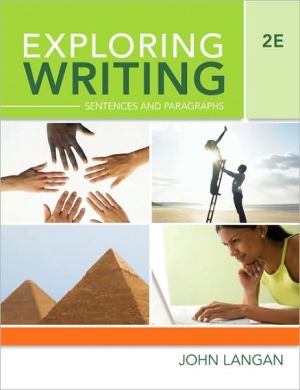Exploring Writing: Sentences and Paragraphs
Exploring Writing: Sentences and Paragraphs serves as a guidebook for every step of the writing process. Emphasizing both process and practice, with a focus on revision, the new second edition helps to apply and advance writing skills using John Langan’s proven techniques. Mastering essential sentence skills, learning to write effective sentences, paragraphs, and essays, and becoming a critical reader are turning points for every writer, and they will prepare the students for writing...
Search in google:
Becoming a writer is a journey, and Exploring Writing: Sentences and Paragraphs will serve as your students’ guidebook every step of the way. Emphasizing both process and practice, with a focus on revision, this text will help students apply and advance their writing skills. Mastering essential sentence skills, learning to write effective paragraphs, and becoming a critical reader are turning points for every writer, and they will prepare the students for writing situations in college and beyond.
PrefacePART ONE/ WRITING: SKILLS AND PROCESS1. An Introduction to Writing Understanding Point and Support An Important Difference Between Writing and TalkingPoint and Support in Two Cartoons Point and Support in a Paragraph Benefits of Paragraph WritingWriting as a Skill Why Does Your Attitude toward Writing Matter? Writing as a Process of Discovery Keeping a Journal 2. The Writing Process How do you reach the goals of Effective Writing?Prewriting Technique 1: FreewritingFreewriting: A Student ModelTechnique 2: QuestioningTechnique 3: Making a List Technique 4: ClusteringTechnique 5: Preparing a Scratch OutlineWriting a First Draft Writing a First Draft: A Student ModelRevising Revising: A Student ModelEditing and Proofreading Editing Tips Proofreading Tips Editing and Proofreading: A Student ModelTips on Using a Computer Using a Computer at Each Stage of the Writing Process Using Peer Review 1. Identification2. Scratch Outline 3. Comments Review Activities Prewriting Outling, Drafting, and Revising Outlining TWO/ WRITING EFFECTIVE PARAGRAPHS3. Four Steps for Writing, Four Bases for Revising What Are the Steps in Writing Effective Paragraphs? Step 1: Make a Point Step 2: Back up Your Point Step 3: Organize the SupportStep 4: Write Clear, Error-Free Sentences Four Bases for Revising Writing Base 1: UnityBase 2: SupportBase 3: CoherenceBase 4: Sentence Skills4. Nine Patterns of Paragraph Development Important Considerations in Paragraph Development Knowing Your SubjectKnowing Your Purpose and Audience1. Exemplification 2. Process A Paragraph to consider Writing Process Paragraph 3. Cause and Effect A Paragraph to consider Writing a Cause-and-Effect Paragraph 4. Comparison and Contrast Two Paragraphs to Consider Writing a Comparison and Contrast Pragraph 5. Definition A Paragraph to Consider WritiParagraphinition Paragraph 6. Classification and Division Two Paragraphs to Consider Writing a Division-Classification Paragraph 7. Description A Paragraph to Consider Writing a Descriptive Paragraph 8. Narration A Paragraph to Consider Writing an Argument Paragraph 5. Moving From Paragraph to EssayWhat Is an Essay? Differences between an Essay and a ParagraphThe Form of an EssayA Model Essay Important Points about the Essay Introductory Paragraph Common Methods of IntroductionSupporting ParagraphsTransitional SentencesConcluding Paragraph Essays to Consider Planning the Essay Outlining the EssayForm for Planning an EssayPractice in Writing the Essay Understanding the Two Parts of a Thesis StatementSupporting the Thesis with Specific EvidenceIdentifying Introductions Revising an Essay for All Four Bases: Unity, Support, Coherence, and Sentence SkillsEssay Assignments Additional Writing AssignmentsPART THREE/ SENTENCE SKILLS SECTION 1: SENTENCES6. Subjects and Verbs7. Fragments8. Run-Ons9. Sentence Variety ISECTION 2: VERBS, PRONOUNS, AND AGREEMENT10. Standard English Verbs11. Irregular Verbs12. Subject-Verb Agreement13. Consistent Verb Tense14. Additional Information about Verbs15. Pronoun Reference, Agreement, and Point of View16. Pronoun TypesSECTION 3: MODIFIERS AND PARALLELISM17. Adjectives and Adverbs18. Misplaced Modifiers19. Dangling Modifiers20. Faulty Parallelism21. Sentence Variety IISECTION 4: PUNCTUATION AND MECHANICS22. Paper Format23. Capital Letters24. Numbers and Abbreviations25. End Marks26. Apostrophe27. Quotation Marks28. Commas29. Other Punctuation MarksSECTION 5: WORD USE30. Dictionary Use31. Spelling Improvement32. Omitted Words and Letters33. Commonly Confused Words34. Effective Word ChoicePART FOUR/ READINGS FOR WRITERS GOALS AND VALUESSister Helen Mrosla, “All the Good Things”Paul Logan, “Rowing the Bus”Marta Salinas, “The Scholarship Jacket”Andy Rooney, “Tickets to Nowhere”Delores Curran, “What Good Families Are Doing Right”EDUCATION AND SELF-IMPROVEMENTBen Carson, “Do It Better!”James Lincoln Collier, “Anxiety: Challenge by Another Name”Anita Garland, “Let's Really Reform Our Schools” Janny Scott, “How They Get You to Do That”Rudolph Verderber, “Dealing with Feelings”Grant Berry, “A Change of Attitude” Beth Johnson, “Let’s Get Specific” HUMAN GROUPS AND SOCIETYKatherine Barrett, “Old before Her Time” Amy Tan, “The Most Hateful Words”Bill Wine, “Rudeness at the Movies”Alice Walker, “My Daughter Smokes” Appendix A: Parts of SpeechAppendix B: ESL PointersAppendix C: Sentence Skills Diagnostic TestAppendix D: Sentence Skills Achievement TestAppendix E: Answers to Exercises in Part ThreeAppendix F: A Writer’s Journal








